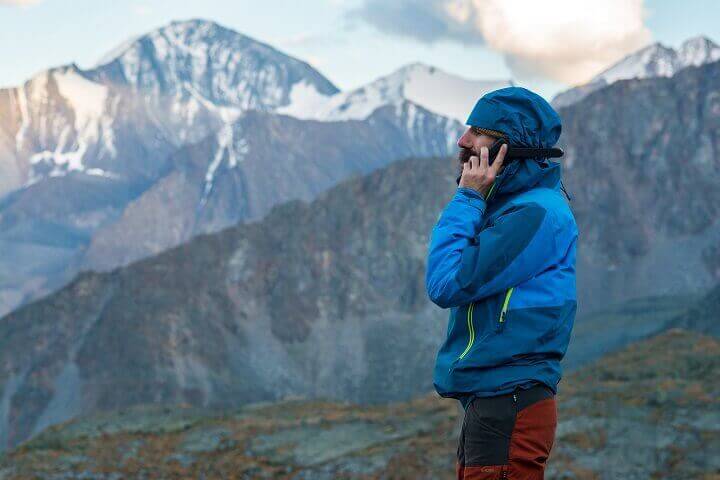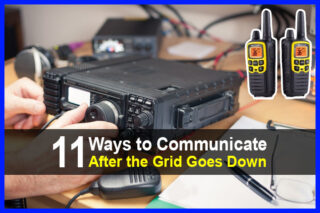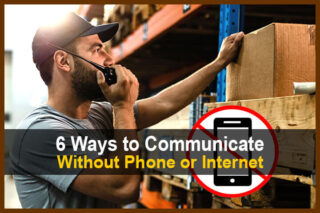Estimated reading time: 9 minutes
SHTF is a general term used to describe a situation that has turned bad or even very bad. It is a time where a person will be confused, frightened, possibly injured, and they may not know what to do. On top of all that, it is likely that the people you care for may not all be in the same place at the same time when this happens.
During such an event, you may want to stay in touch with loved ones or you may need to convey information to them to bring them home safely. The problem is that when the SHTF, we may not be able to use the same methods of communication as we did before things went south. The passing of information and being able to talk to others has always and will always be key to our survival.
Want to save this post for later? Click Here to Pin It On Pinterest!
Cell Phones/Smartphones
A cell phone/smartphone is going to be your first and best option for contacting friends and family quickly and over a great distance. Everybody, even kids, have a cell phone and they are almost always within arm’s reach.
The problem with cell phones is that during an emergency, the network may be overloaded and not all the calls that are made can get through. We have seen evidence of this whenever there is a largescale emergency or natural disaster.
However, if a call cannot get through, it may still be possible for a text message to get through. Always follow up a failed phone call by sending text messages.
If the above two methods fail but internet access is still available, there are other things you can try. Attempt to make contact by using email, social media platforms, video calls, and any other communication-based application.
If you are having difficulty contacting your loved ones with the above methods, try using the same methods to contact other people that are likely to be in proximity to your loved ones, such as a neighbor. You never know, you may just get lucky and a message could get through to them.
The biggest downside to relying on a cell phone or smartphone is that if the network or local cell towers are negatively affected, then none of the above options will work. Additionally, the phone will not be a long-term means of communication if you do not also plan for keeping the battery charged.
Computers and Tablets
If your phone is not working, a computer or tablet can be used in many of the ways a cell phone is used. A computer or tablet would be the second option to use as almost everyone has one and again, they work quickly over large distances.
Contact with friends and loved ones can be made through email, social media platforms, and any other program that allows communication between two parties. Just like cell phones though, these two devices will require an internet connection to operate in this manner.
Landline
The great thing about landlines is that many of the things that can negatively affect cell phones, won’t affect a landline. The downside of course is that landlines cannot be carried around, and many people no longer use them, at least not in their homes.
Even if you go to a local business and use theirs, the person you are attempting to contact will need to have one as well if their cell phone is not working. Landlines may not provide as many methods for communication as the above two options, but they can certainly be more reliable and should be a part of everyone’s plan.
Walkie Talkies and HAM Radios
Walkie-talkies are an affordable secondary option. They are widely available as they can be picked up at almost any big box store or sporting goods store. They are also lightweight, compact, and easy to use.
The downsides to walkie-talkies are security and range. In terms of security, anybody within range of you can listen in on your conversation with another walkie-talkie or even a baby monitor.
Their range is also an issue. For example, some packages list the device as being able to reach up to forty miles, but you would be lucky to get half that range depending on the region and environment they are being used in.
A healthy supply of batteries or a means of charging should also be planned for. Walkie talkies can be a bit bulky but more importantly, they have a limited range, which in part is why people don’t carry them around all the time.
HAM radios are somewhat similar to walkie-talkies, but they work over a greater distance. The devices can be handheld and carried around or more complex, larger versions can be set up in a designated area.
HAM radios are more expensive than walkie-talkies, and there is a learning curve for how to use one. Also, the frequencies that are used are regulated and monitored at the federal level so you will need to become a licensed operator to use one, at least before the SHTF.
Satellite Phones
Satellite phones, or sat phones, are a great option for when cellular towers are down or for when you are far away from one. This is because satellite phones bypass the towers altogether and provide a direct line to a satellite.
The upside is that these phones can be used almost anywhere on the planet, which is a very appealing feature. However, there are a few downsides to them. First, satellite phones are expensive. On the cheap end, they start at several hundred dollars per unit. So, getting one for each member of a large group may not be financially feasible. Secondly, they work best outdoors when the signal has a clear line of sight to the satellite and the satellite must be in range overhead.

Old School Drop Site
Depending on how bad the situation is and your ability to travel, an old-school drop site could be set up before the SHTF. This entails setting up a location that everyone in your group is aware of where messages could be left. The location would work just like a mailbox where people could leave messages or even supplies for others to pick up.
Drop sites are easy to use but they do require proper planning beforehand. Unless you want anyone to have access to your communications or supplies, the site should be camouflaged and located in a spot that is not easily stumbled upon. It also wouldn’t be a bad idea to select a few sites that are scattered over a large area to improve your chances of making contact.
Putting A Plan Together
Contacting those that you love during a disaster may be difficult and sometimes even impossible, which is frustrating and worrisome. To alleviate the stress of this situation, you, your friends, and your family need to sit down and develop a detailed communications plan before the SHTF.
When given a list of solutions, people will generally pick one or two options from the list. Communications with your friends and family as well as the transference of information are so important that your plan should utilize all available options.
Below is a brief overview of what a communications plan would look like.
- First, use a cell phone and all its available methods such as calls, email, texts, social media, etc. to contact designated parties.
- Next, if the internet is still working but your phone is not, find a computer or tablet to make contact with designated parties using the available methods that are similar to a smartphone.
- If the network is down or not responding, go to X location where there is a landline and use it to try and make contact with designated parties. Also, wait X amount of time at that location to allow others to try and contact you. You should only wait the the pre-determined amount of time for contact if the area in which you are in is safe to do.
- When cell phones, computers, and landlines do not work, move on to using radios such as walkie-talkies, HAM radios, and satellite phones if they are available.
- In the case that none of the above options are working, use physical drop-off sites as a means of communication.
The above steps are only half of the plan. The other part is thinking about the security of what is communicated because you never know who is listening in or who may stumble across messages that were meant for someone else.
I know this part may seem a bit paranoid but remember that if S has HTF, then things are bad and people will become desperate. Imagine the following scenario.
A parent and their kid are separated but are finally able to make contact through a phone call. The kid is talking on a phone in a public place where the people who are there know the kid and their family.
After a few moments the kid says something like, “Yeah dad, I know. I'll meet you at grandpa's house because it's safe and he has a ton of supplies.”
Anyone that heard this conversation now knows that the kid's grandfather's place is safe and has supplies. They can either go directly there or follow the kid when they leave.
Instead of using specific names and locations, it would be wise to come up with a code that you and your loved ones can use. For example, instead of saying grandpa's house, call it location A or B. A code as simple as this can help to prevent others from causing any further harm to you and your loved ones.
Conclusion
One of the keys to success in any battle is reliable intelligence. When the SHTF, the ability to relay information and to contact loved ones will be just as important. By taking the time to put together a detailed communications plan you will not only remove a lot of stress from the situation but the odds of survival for you and your loved ones will be greater.
Are there other forms of communication that you have planned for when SHTF? Be sure to leave a comment below and let us know about it.
Like this post? Don't Forget to Pin It On Pinterest!












And another article giving personal opinion and nothing based in fact. Who dreams up this stuff anyway?
RayM, do you have a better plan based on fact? I would be glad to hear it.
The first on the list is landline. I have never in recent years found that our cell phones work in even a minor localized power outage. The landline “always” does. The same goes for computers. Walkie talkies are okay for very short distance communication and only if others are up to par with you. Satellite phones????? There is no one in my world that can afford one. ‘Nuff said. Apparently you have never been in a real emergency situation. Sorry if I’ve ruffled any feathers. I just speak from real life experience and I’ve been around for 75 years. I tried most of the ideas and most don’t work or need very tight controlling factors which most either can’t afford or don’t have needed facilities to employ. Again, I apologize for being straight forward but I think this subject deserves absolutely honest and well researched information. Stay safe and God bless.
Hi Team,
Hope this message finds you well!
Do you accept link insertions in old blog posts? If yes, what’s the cost?
If not, how about a 3-way link exchange to boost website rankings?
Cheers,
Keily Anderson
Nomad Hubz
Sorry but we don’t sell links.